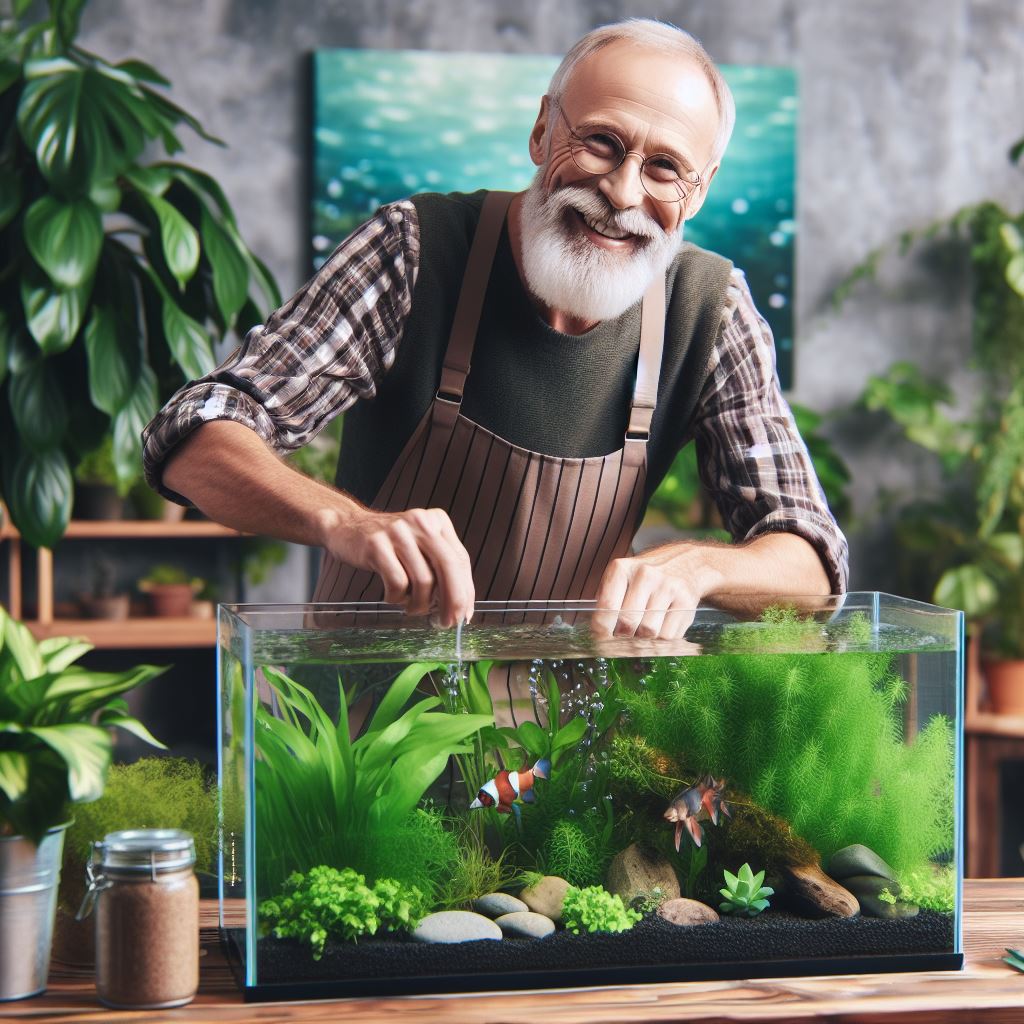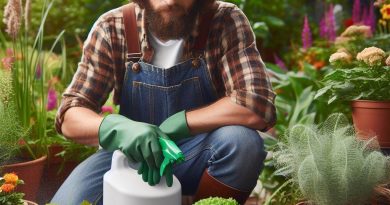Water Works: Basics of Home Aquaponics
Last Updated on March 2, 2024
Introduction
Home aquaponics is a sustainable farming method that combines aquaculture and hydroponics in one system.
This concept leverages the symbiotic relationship between fish and plants to create a closed-loop ecosystem.
With the increasing focus on eco-friendly and self-sufficiency practices, aquaponics is gaining popularity globally.
The benefits of home aquaponics are numerous, including reduced water usage, minimal chemical inputs, and higher yield.
This system allows homeowners to grow fresh vegetables and fish in a compact space, even in urban environments.
Aquaponics also eliminates the need for soil, making it a viable option for areas with poor-quality soil or limited land.
By utilizing nutrient-rich fish waste as a natural fertilizer, plants in the system grow faster and healthier.
Furthermore, the combination of fish and plants creates a balanced ecosystem that requires low maintenance.
The growing popularity of home aquaponics can be attributed to its sustainability, efficiency, and the ability to customize the system.
With a greater understanding of aquaponics and its benefits, more people are eager to create their own home aquaponics systems.
In the following sections, we will delve deeper into the mechanics, setup, and maintenance of a home aquaponics system.
What is Aquaponics?
Aquaponics is a sustainable farming method that combines aquaculture (raising fish) and hydroponics (growing plants without soil) in one integrated system.
Basic Principles of Aquaponics
The basic principles of aquaponics involve creating a symbiotic relationship between fish and plants.
Symbiotic Relationship Between Fish and Plants
In an aquaponics system, the fish produce waste, which is rich in ammonia.
Ammonia is toxic to fish, but it serves as a fertilizer for the plants.
The waste is broken down by bacteria in the system, converting ammonia into nitrates.
Plants then absorb nitrates as a source of nutrients, effectively filtering the water for the fish.
This symbiotic relationship creates a natural and efficient way to grow both fish and plants.
How the Aquaponics System Works
The aquaponics system consists of several main components.
Fish Tank
The fish tank is the heart of the system, where the fish are raised.
Fish waste accumulates in the tank and provides nutrients for the plants.
Grow Bed
The grow bed is where the plants are grown. It is usually filled with a growing medium like gravel or clay pellets.
Water from the fish tank is pumped into the grow bed, allowing the plants to absorb nutrients from the fish waste.
Water Pump
A water pump is used to circulate the water between the fish tank and the grow bed.
This ensures a continuous flow of nutrients for the plants and oxygen for the fish.
Biofilter
The biofilter is a crucial component that houses beneficial bacteria.
These bacteria convert ammonia into nitrates, which are then absorbed by the plants.
Additional Components
Other components in an aquaponics system may include a sump tank, where excess water is collected and filtered, and a heater or chiller to maintain optimal water temperature.
Benefits of Aquaponics
Aquaponics offers numerous benefits.
Firstly, it is a sustainable farming method that conserves water and eliminates the need for chemical fertilizers.
The system also reduces the risk of diseases and pests, as it is a closed-loop system.
Furthermore, aquaponics allows for year-round cultivation, as it can be adapted to different climates.
Aquaponics is a fascinating and innovative way to grow both fish and plants in a symbiotic system.
By understanding the basic principles and components of aquaponics, anyone can set up their own home aquaponics system.
Not only does aquaponics provide a sustainable and efficient method of farming, but it also allows individuals to have fresh produce and fish right in their own homes.
So, if you’re looking for a new and exciting way to grow your own food, consider trying out aquaponics!
Read: Urban Farming: Aquaponics in the City
Setting up a home aquaponics system
Aquaponics is a sustainable method of farming that combines aquaculture and hydroponics systems.
It allows you to grow fish and plants together in a symbiotic environment, where the fish waste provides nutrients for the plants, and the plants purify the water for the fish.
If you’re interested in starting your own home aquaponics system, follow this step-by-step guide:
Plan your system
- Determine the location of your system, considering factors like sunlight, temperature, and space availability.
- Decide on the size and type of aquaponics system you want – there are various options such as media beds, nutrient film technique, or deep water culture.
Gather the necessary equipment and materials
- Fish tank or aquarium: serves as the “home” for your fish.
- Grow bed: the area where you’ll plant your chosen vegetables or herbs.
- Water pump: circulates water between the fish tank and grow bed.
- Air pump: provides oxygen to the fish and plants.
- Pipes and fittings: to connect various components of the system.
- pH and ammonia testing kits: essential for monitoring water quality.
- Gravel or clay pebbles: used as a planting medium for the plants.
Set up the fish tank
- Fill the fish tank with water and dechlorinate it if necessary.
- Install the water pump and air pump in the tank.
- Introduce the chosen fish species, ensuring they are compatible with the size of your tank.
Set up the grow bed
Place the grow bed above the fish tank, allowing water to flow from the tank to the bed.
Fill the bed with the chosen planting medium and plant your desired vegetables or herbs.
Establish the cycling process
- Start the cycling process by adding ammonia to the system.
- Monitor the ammonia and nitrite levels regularly, as they indicate the progress of the nitrogen cycle.
- Once the system has established nitrates and the plants are growing, it is ready for fish.
Choose the right fish and plant species
- Research and select fish species that thrive in aquaponic systems, such as tilapia, trout, or catfish.
- Choose plant species that are suitable for the water conditions and grow well in the planting medium.
Maintain and monitor your system
- Regularly check water parameters such as pH, ammonia, nitrite, and nitrate levels.
- Feed the fish and observe their behavior and health.
- Ensure proper lighting and temperature to support plant growth.
- Prune and harvest plants as they mature to maintain a balance in the system.
Essentially, setting up a home aquaponics system requires careful planning, the right equipment, and choosing compatible fish and plant species.
With proper maintenance and monitoring, you can enjoy a sustainable and thriving aquaponics system right in your own home.
Read: Aquaponics 101: Fish & Plants in Harmony
Maintaining a home aquaponics system
Maintaining a home aquaponics system is crucial to ensure the overall health and productivity of the system.
Here are some key aspects to consider:
Water Quality Monitoring
Regularly monitoring and maintaining the water quality is vital for the well-being of both the fish and the plants.
- Check the pH levels of the water weekly to ensure they remain within the optimum range for both fish and plants.
- Monitor the levels of ammonia, nitrate, and other chemicals that can impact the water quality.
- Use testing kits to periodically evaluate the nutrient levels in the water and adjust accordingly.
By keeping a close eye on the water quality, you can detect any potential issues and take corrective measures promptly.
Feeding the Fish
Proper feeding practices play a crucial role in maintaining a healthy aquaponics system.
- Feed the fish a balanced diet that fulfills their nutritional requirements. Consult an aquaponics expert or do thorough research to determine the most appropriate fish food.
- Avoid overfeeding the fish as it can lead to excess waste production, which can negatively impact water quality.
- Observe the behavior and appearance of the fish to ensure they are healthy and actively feeding.
Regularly monitoring the fish’s feeding habits will help identify any potential health issues early on.
Maintaining Nutrient Balance for Plants
Providing the right nutrient balance for the plants is essential for their growth and productivity in an aquaponics system.
- Use organic and fish-safe fertilizers to supplement the nutrient requirements of the plants.
- Monitor the nutrient levels in the water and adjust them as needed to prevent deficiencies or excesses.
- Regularly prune the plants and remove any dead or decaying parts to maintain a healthy growth environment.
Additionally, ensure that the plants receive adequate light and maintain the appropriate temperature and humidity levels in the growing area.
Preventing Common Issues
There are a few common issues that need to be addressed to maintain a healthy aquaponics system:
- Regularly clean and maintain the system’s filters, pumps, and pipes to prevent clogging and blockages.
- Prevent the growth of algae by limiting exposure to direct sunlight and implementing algae control methods, if necessary.
- Prevent pests and diseases by maintaining proper hygiene and employing natural pest control methods, if needed.
Addressing these common issues proactively will help prevent disruptions in the system’s functioning and ensure its longevity.
In general, maintaining a home aquaponics system involves monitoring water quality, feeding the fish properly, and maintaining a nutrient balance for the plants.
By paying attention to these key aspects and addressing common issues promptly, you can enjoy a healthy and productive aquaponics system in your home.
Read: DIY Hydroponics: Start Your Soil-less Garden!

Find Out More: Soil Aeration Techniques for Healthier Roots
Benefits of home aquaponics
Home aquaponics offers numerous benefits, both for the environment and for individuals looking to grow their own organic produce.
By combining aquaculture (fish farming) and hydroponics (growing plants in water), aquaponics creates a sustainable and self-contained system that has a positive impact on water conservation, reduces the use of chemicals, and provides pesticide-free food.
Environmental Benefits of Aquaponics
- Water Conservation: Aquaponics uses 90% less water compared to traditional soil-based farming. The water is continuously recirculated, greatly reducing water waste.
- Reduced Chemical Use: Since aquaponics relies on biological filtration to clean the water, there is no need for synthetic fertilizers or pesticides. This helps protect the environment from harmful chemical runoff.
Growing Organic and Pesticide-Free Produce at Home
One of the main advantages of home aquaponics is the ability to grow organic and pesticide-free produce right in your backyard.
By controlling the entire process, you can ensure the quality and safety of the food you eat.
Saving Money in the Long Run
Aquaponics may require an initial investment in equipment and setup, but it can save you money in the long run.
Here’s how:
- Reduced Grocery Bills: Growing your own produce means you don’t have to buy it from the store, saving you money on groceries.
- Lower Water Bills: With water conservation being a key feature of aquaponics, you’ll see a significant reduction in your water bills over time.
- No Need for Chemicals: By eliminating the need for synthetic fertilizers and pesticides, you can save money on expensive agricultural chemicals.
- Higher Yield: Aquaponics systems allow for faster growth and higher yields compared to traditional farming, maximizing your return on investment.
In essence, home aquaponics offers a range of benefits.
From helping conserve water and reduce chemical use to providing a sustainable way to grow organic produce, it is an eco-friendly and cost-effective solution for anyone interested in gardening and sustainable living.
By embracing this innovative farming technique, individuals can enjoy fresh, healthy food while contributing to a greener future.
Read: Eco-Friendly Pots: Sustainable Gardening
Challenges and Troubleshooting in Home Aquaponics
Aquaponics is a sustainable and efficient method of growing plants and raising fish together in a symbiotic environment.
However, like any other system, home aquaponics can face challenges and issues that need troubleshooting.
In this section, we will discuss some common problems and provide solutions to ensure a successful aquaponics setup.
Algae Growth
- Problem: Algae growth can occur in the aquaponics system, blocking sunlight and nutrients from reaching plants.
- Solution: To control algae growth, minimize light exposure by covering the fish tank and using light-proof material.
- Troubleshooting Tips: Regularly clean the grow bed and fish tank to remove excess algae. Introducing algae-eating fish or snails can also help control algae growth.
Fish Diseases
- Problem: Fish in the aquaponics system can be susceptible to diseases, leading to poor health and possible death.
- Solution: Maintain good water quality, proper nutrition, and regular monitoring to prevent fish diseases.
- Troubleshooting Tips: Quarantine new fish before introducing them to the system. Treat any signs of illness promptly and avoid overfeeding fish to prevent poor water conditions.
Nutrient Imbalances
- Problem: Nutrient imbalances can occur in the aquaponics system, affecting plant growth and overall productivity.
- Solution: Monitor nutrient levels regularly and adjust as necessary to maintain proper balance.
- Troubleshooting Tips: Test water quality regularly to ensure optimal nutrient levels. If deficiencies or excesses are detected, adjust the fish feed or supplement with appropriate nutrients to restore balance.
Continuous Learning and Adapting
It is crucial to understand that aquaponics is a dynamic system that requires continuous learning and adaptation.
As a home aquaponics enthusiast, you should be open to new information and willing to make necessary adjustments to optimize your system’s performance.
- Importance of Continuous Learning: Stay updated with the latest research, techniques, and best practices in aquaponics to enhance your system’s efficiency.
- Adapting to Changes: As your plants and fish grow, make adjustments in feeding rates, filtration, and water flow to meet their changing needs.
- Troubleshooting Tips: Keep a record of your system’s performance and outcomes. Analyze any issues or setbacks and seek advice from experienced aquaponics practitioners or online forums.
Remember, home aquaponics is a journey that requires patience, observation, and active problem-solving.
By identifying common problems, applying appropriate solutions, and continuously learning, you can overcome challenges and enjoy the benefits of a thriving aquaponics system.
Uncover the Details: Harvesting Hints for Maximum Yield
Conclusion
Home aquaponics offers a sustainable and self-sufficient solution for growing food at home.
We have discussed the basics of aquaponics, including the symbiotic relationship between fish and plants and the importance of maintaining water quality.
Aquaponics has the potential to revolutionize how we view agriculture by reducing water usage, eliminating the need for harmful chemicals, and producing two valuable resources simultaneously: fresh produce and fish.
If you are interested in trying out aquaponics, there are plenty of resources available to help you get started.
Online forums, instructional videos, and books can provide in-depth knowledge and step-by-step guidance.
By incorporating home aquaponics into our lives, we can enjoy fresh and organic food while reducing our environmental impact.
Give aquaponics a try and embrace the possibilities of sustainable and self-sufficient living.


